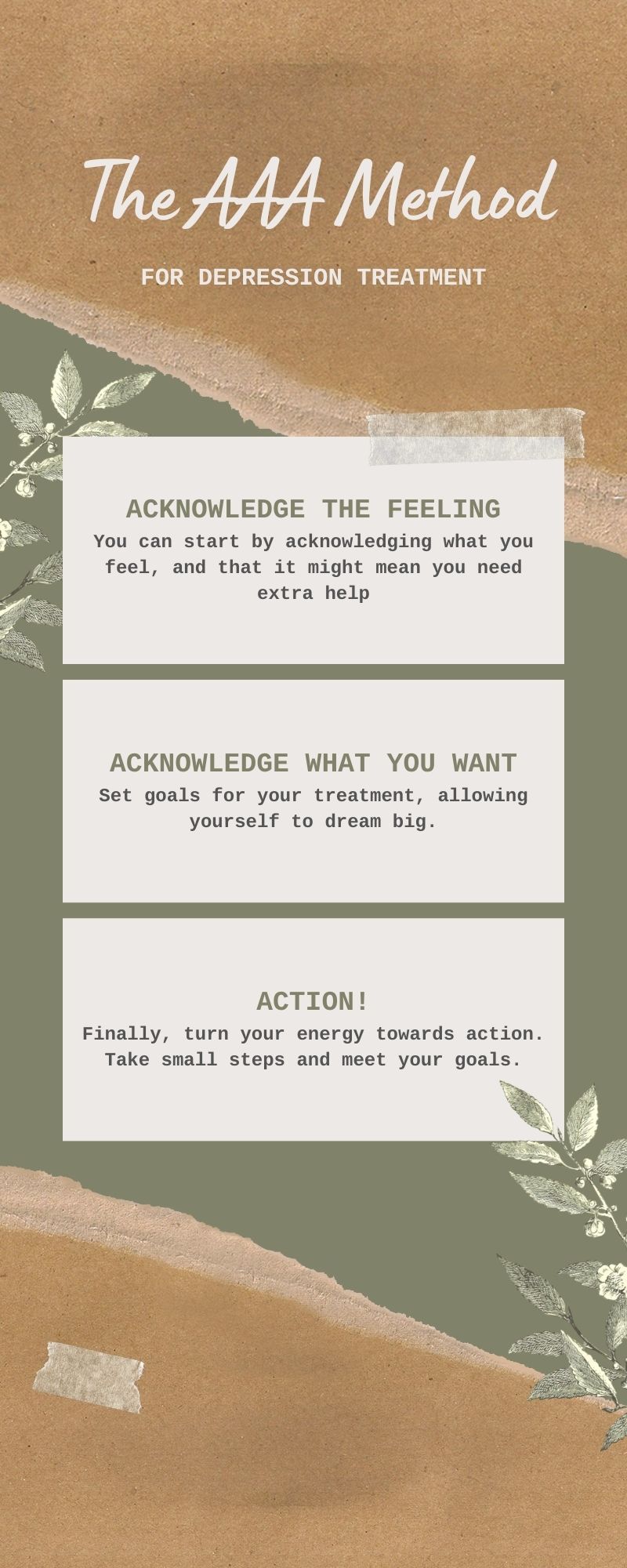Learn / Goals of Depression Treatment (AAA)
Goals of Depression Treatment (AAA)


April 11th, 2023| Clinically Reviewed by
Key Points
- Acknowledgement: Feel your feelings, and what they mean for you.
- Acknowledge what you want to come next.
- Action: Take the next steps to make it come true.
You need more than a quick fix to treat depression. Depression won’t go away overnight, but that’s okay. That’s why therapy is a continual process that supports medication management, and vice versa. The goal, then, of depression treatment is to work through its root causes and teach you how to navigate daily life with more hope, ease, and joy.
Through treatment, you can learn to manage depression and navigate your emotions. Talking with your doctor can help you decide which level of care is best for you. You could even attend a rehab for depression.
Depression treatment could take many directions. Dr. Malasri, psychologist and Senior Director of Content at RehabPath, describes her AAA method below.
“The more we focus on perseverative thoughts, the more they will prevail. To work through them, it is crucial to take the AAA approach: Acknowledge, Acknowledge, Action. The first round of Acknowledgement involves listening to yourself and acknowledging what you are truly feeling. In the second round of acknowledgement, you need to acknowledge the aspiration—what do you actually want to bring to your life, what are you seeking? Finally, take action—this is where you create an action plan that will enable you to take your solutions and break them down into monthly, weekly, and daily goals.”
You can use this method during and between therapy sessions. Using AAA, you can have progressive conversations with your therapist and yourself, and an all-around more successful treatment experience.

Acknowledgement
The first step and goal of depression treatment is acknowledgement. You can acknowledge your symptoms, how they affect your life, and that they could mean you need extra help. Doing so might be your first step to healing.
You can do this with yourself, a therapist, or both. Because therapy doesn’t stop once you leave a session—it’s also every moment in between.
Your therapist can help you work through and resolve what contributes to your symptoms, especially if it feels hard to identify. For example, you might try to navigate a difficult job situation by identifying its pain points and seeing if you can relieve them. Or, your therapist could help you navigate a toxic relationship or living situation.
Once you’ve acknowledged what’s going on and how you’re feeling, you can move onto the second phase of acknowledgement.
Acknowledge What You Want
What do you want to happen next? What do you seek? Take some time to reflect on this. Dream, visualize, and see what you can imagine for yourself.
What does happiness look like? What does your ideal work experience look like? What motivates you? What are your sources of inspiration?
Try to be realistic as you do this—taking off too big a chunk might feel daunting. Identify what you want here. Think of a blank canvas, and what picture you want to paint.
And once you know what you want, you (and your therapist) can begin making it happen.
Explore Depression Treatment Centers
Action: Plan Your Next Steps
Sometimes, leaving the cycle of depression can seem scary—paralyzingly so. Once you acknowledge this cycle and your goals, you can redirect your energy into action. Alone or with help, you can identify manageable steps that you can accomplish daily, weekly, and monthly. These form your action plan.
You need to paint your dreams with paced, manageable steps. Here, it’s important to remember that small steps in your plan might feel easier to follow and commit to.
For example, you might take a walk each day. Some days you might feel up to something bigger. Take that motivation and focus on the pace you created. On the days where it seems undoable, take that energy, go back to acknowledging those emotions, breathe through it, and remind yourself of your paced approach.
Give yourself compassion—and space to breathe in your action plan.
Committing to the process could be invaluable, especially since, like other conditions, depression requires maintenance. It won’t vanish on its own. And once it’s gone, there’s always the chance it could come back.
Maintaining your treatments, like therapy, self-care and medication management, can keep recurrent episodes at bay.
And you can always come back to AAA. The process has no expiration date, and it’s yours.
Break The Chains Without Fear
Despite how it may feel, depression can go away with proper treatment. The goal of treatment isn’t to give you a fast cure. Rather, it’s to give you systems and plans to manage the condition.
If you think residential treatment for depression could help you best, you can browse our list of depression rehabs and see pictures, pricing, and reviews.
Return to Resource Library
Our Promise
How Is RehabPath Different?
We believe everyone deserves access to accurate, unbiased information about mental health and addiction. That’s why we have a comprehensive set of treatment providers and don't charge for inclusion. Any center that meets our criteria can list for free. We do not and have never accepted fees for referring someone to a particular center. Providers who advertise with us must be verified by our Research Team and we clearly mark their status as advertisers.


















